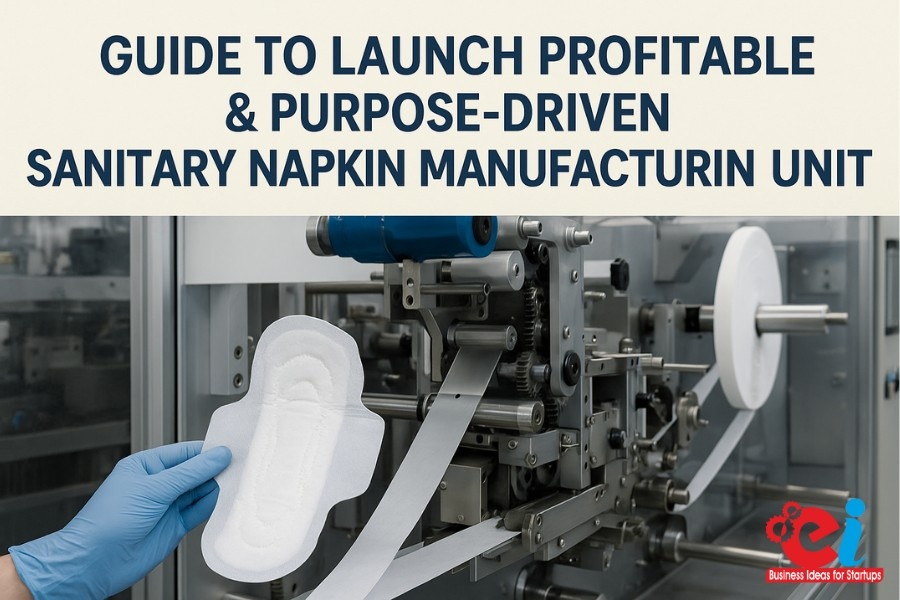There has been a shift in the perception of woman’s health in developing countries like India in the recent past. Unfortunately, there continues to be a huge gap with accessing affordable and quality sanitary napkin in rural and semi-urban regions. Subsequently, there is an unmet demand for the establishment of sanitary napkin manufacturing plants that would not only be profitable but also aid in bridging the socio-economic divide.From NGO’s, woman entrepreneurs, investors and even startup founders, this guide serves as a go-to for all stakeholders by explaining every aspect of setting up a sanitary napkin manufacturing plant from market research to securing finances as well as securing raw materials, machinery, and even getting legal clearances.
Sanitary napkins are one of the most heavily relied upon menstrual hygiene products and hence, NPCS (NIIR Project Consultancy Services) has dedicated profiles to aid individuals in meeting their goals through guiding them towards informed, feasible, and purpose driven decisions.
1. Market Research and Feasibility Study
Research from the Indian and Global Markets
Estimates show that the global sanitary napkin market value was estimated at $23.2 billion in 2022 with an expectation of reaching $33.5 billion by 2030, which is a steady growth of 5.2% annually.
In India, there is a surge in the use of modern menstrual pads but only 42% of menstruating women use sanitary pads. Thus, there is a lot of potential in the rural areas of the country.
Key Advantages of the Growth Opportunity
- Programs such as MHS and Beti Bachao Beti Padhao
- Campaigns run in schools and colleges
- Urbanization and the rise in female literacy
- Development of retail and e-commerce
Target Market Segment
- Women in rural areas through government/NGO distribution
- Consumers living in urban and semi-urban areas
- Hospitals and maternity clinics
- School and college sanitary programs
- Modern retail stores
2. Types of Sanitary Napkins
| Type | Template |
| Regular Pads | Moderate to Light flow basic pads |
| Ultra-thin Pads | Women’s slimmer and discreet protection pads with gel-based absorbency core |
| Overnight Pads | Pads designed for overnight use which are larger |
| Panty Liners | Light pads which are used for the purpose of freshness and daily use |
| Biodegradable Pads | Sanitary Pads made from eco-friendly materials such as bamboo, banana fiber, cotton pulp |
| Customizable Pads | Pads designed for teenage, post-natal, or incontinence use |
3. Step-by-Step Guide to Setting Up a Sanitary Napkin Manufacturing Unit
Step 1: Market Research and Feasibility Study
NPCS provides a comprehensive study under their Detailed Techno-Economic Feasibility Report which includes:
- Demand and supply assessment
- SWOT and profitability evaluation
- Investment assessment
- Projected break-even analysis
- Competitive analysis
Step 2: Selecting an Appropriate Business Model
| Scale | Daily Output Capacity | Best Suited For |
| Cottage/Manual | 1,000–2,000 pads | Self-help groups, NGOs, etc. |
| Semi-Automatic | 5,000–15,000 pads | Small enterprises and rural self-employed |
| Fully Automatic | 50,000+ pads | Industrial production, exporters of goods |
Step 3: Required Legal Registrations and Licenses
- Company Registration, MSME/Startup India
- GST Registration
- BIS Certification: IS5405:1980 (sanitary pads)
- Factory License
- Pollution Control Certificate
- Trade mark/ brand registration
NIIR Consultancy also helps clients with government subsidy registration, PMEGP loan aid, and ECLGS scheme assistance.
Related: Investment Opportunities in India: Sanitary Napkin Project
Step 4: Infrastructure and Land Requirements
Basic Manufacturing Setup
- Production area (~1000–1500 sq. ft.)
- Raw material storage
- Packaging section
- Office and administrative area
- Waste disposal and water treatment facilities
Utilities Required
- Electricity (10–30 kW depending on machinery)
- Water (basic for cleaning and washrooms)
- Compressor air (if automatic machines are used)
Step 5: Raw Material Procurement
| Material | Function |
| Non-woven fabric | Top sheet (soft surface) |
| Pulp paper (fluff) | Core absorbent material |
| SAP (Super Absorbent Polymer) | Enhances absorption and gel formation |
| Polyethylene film | Back sheet to prevent leakage |
| Release paper | Protects adhesive during packaging |
| Glue & Hot Melt Adhesive | For fixing pad layers |
| Packaging material | Individual wrappers, box packaging |
Raw materials are available with suppliers in Maharashtra, Gujarat, Tamil Nadu, and Delhi NCR.
Step 6: Machinery and Equipment
| Machine Name | Function | Cost (INR) |
| Sanitary Napkin Making Machine | Core forming and sealing | ₹10–50 Lakhs+ |
| Sterilizer (UV/Heat) | Sterilizes and ensures hygiene | ₹1–2 Lakhs |
| Sealing & Packing Machine | Pads sealing and wrapping | ₹2–5 Lakhs |
| Compressor | For automatic units air-based systems | ₹1 Lakh+ |
| Misc. Tools | Weighing, cutters, etc. | ₹1–2 Lakhs |
NPCS project reports have current updated machinery expenses, suppliers, and plant layout designs.
Step 7: Manufacturing Process Flow
- Raw Material Preparation: Pulps rolls along with the fabrics are unrolled semicircularly, and the strips of required dimensions are sliced.
- Forming Core: SAP is added to fluff pulp.
- Layering And Bonding: A top sheet, core and back sheet are aligned and bonded together.
- Edge Cutting and Shaping: Pads are ergonomically shaped and trimmed.
- Adhesive Application: Glue is applied for the backing and stick-on wings.
- Sterilization: UV or heat is used for Pads sterilization.
- Packing: Pads are packaged into pouches or boxes.
- Quality Testing: Pads are tested for size, softness, absorbency and other criteria.
Related: Biodegradable Personal Care Products: Diapers and Sanitary Napkins
8. Pad Production Workforce Requirement
| Job Description | Head Count (for 10,000 Pads/Day) |
| Production Operators | 4–5 |
| Quality Supervisor | 1 |
| Machinery Technicians | 2 |
| Admin and Sales Executive | 2 |
| Packers | 3–4 |
Conduct ongoing training sessions on:
- Hygiene and cleanliness
- Safety of machinery
- Quality assurance procedures
9. Strategic Marketing and Distribution
Offline:
- Cottage republic distribution via ASHA and NGOs
- Agreements with higher education institutions
- Direct campaigns from sales to clients
Online:
- Establish your own D2C e-commerce storefront
- Develop listings on Amazon, Flipkart, and Meesho
- Engage in social media advertisements via YouTube, Instagram, and Google
Government/NGO Tenders:
Partake in the tender for supply of sanitary napkins from:
- Ministry of Health and Family Welfare
- Women and Child Development Departments
- Corporation House CSR projects
10. Project Investment & Financial Estimates
| Costs | Investment Amounted (INR) |
| Machinery and other tools | ₹25 – 50 Lakhs |
| Land and Building (Lease) | ₹5–10 Lakhs Annually |
| Raw Materials (quarterly) | ₹10–15 Lakhs |
| Packaging Campaigns | ₹2–5 Lakhs |
| Utilities and other expenses | ₹3–5 Lakhs |
| Working Capital | ₹15–20 Lakhs |
Estimated Total Investments:
Contingent Estimate Towards Investment: ₹60 Lakhs – ₹1 Crore
Projected Revenue for Producing 10,000 Pads/Day:
- Sale Price per Pad (Bulk): ₹2–₹3
- Monthly Earnings: ₹6–₹9 Lakhs
- Expenses: ₹1.5–₹2.5 Lakhs
- Returns on Investments: 28–35%
- Time to amortize initial investment: 18–24 months
11. Government Aids & Grants
- Prime Minister’s Employment Generation Programme (₹25 Lakhs loan with 15–35% subsidy)
- MSME Linked Subsidy of Capital
- Recognition under ‘Startup India’ scheme
- Women Empowerment Programs through NABARD and SIDBI
- Funding for NGO-led sanitary pad aid through CSR
12. NPCS Services for You
NIIR Project Consultancy Services provides complete guidance by offering:
- Customized Detailed Project Reports (DPRs)
- Leading and forecasting for the market along with demand
- Strategic financial planning alongside break-even analysis
- Designing plant layout and infrastructure
- Compiling suppliers list for machineries and raw materials
- Assisting with application for loans and subsidized aid
- Strategizing on project implementation
To view pre-existing reports or to order a bespoke feasibility report for your business on sanitary napkin manufacturing, visit:
🌐 entrepreneurindia.co
📧 npcs.ei@gmail.com | 📞 +91 9097075054
Conclusion
The sanitary napkin manufacturing sector stands at the crossroads of exceptional profitability woven with meaningful social impact. A shift in focus toward the hygienic menstrual needs, particularly in rural India, calls for attention to mark entry into this domain.
Following the recommendations laid out in this comprehensive guide, in combination with the seasoned guidance from NIIR Project Consultancy Services, prospective business owners are poised for success as they set out to establish and expand their sanitary pad manufacturing business, simultaneously enhancing women’s health dignity.
Invest today to create change and empower women while ensuring optimum profits.

























